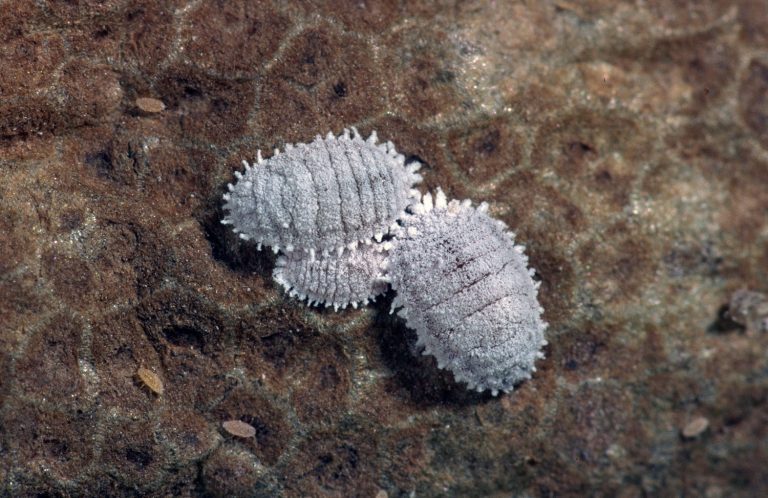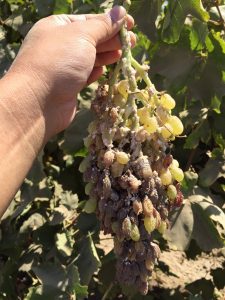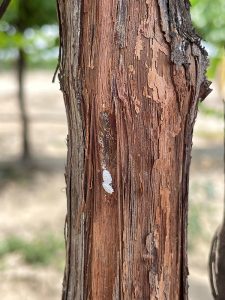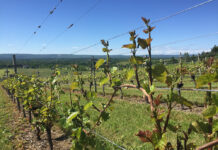
Considering the breadth of the California wine grape industry, when vine mealybug is tagged as being the most important insect pest, growers take that threat seriously.
Vine mealybug (VMB), Planococcus ficus, was brought into California on infested vineyard cuttings. This invasive pest is found throughout all California wine grape growing regions, with severity of infestation depending on regional climate conditions. When feeding on the sap of grapevines, VMB produces honeydew that contaminates grape clusters with black, sooty mold, degrading the value. A more serious impact is VMB is its ability to transmit grapevine leafroll associated viruses.
Control options for VMB are limited due to the phenology of this invasive pest. According to the UC Integrated Pest Management guidelines, VMB life stages can be present year-round in vineyards and multiple generations can be produced. Mating disruption can be used as an alternative or supplement chemical control. It is most effective when insecticides are used first to reduce VMB densities in the vineyard. Mating disruption as part of an ongoing control strategy can suppress VMB populations to lower levels.
Andrea Holeman, marketing manager for Suterra, said wine grape growers often do not realize the extent of their VMB infestation until they begin using pheromone lure traps in their vineyards to detect presence of this pest. The traps, yellow sticky cards with the female pheromone, are placed in vineyards at bud swell and attract the males.
Pheromones a Viable Tool
Mating disruption has become a critical part of VMB control strategies in infested wine grape vineyards. Lodi Wine Growers notes that a variety of chemical and biological controls have been developed to target VMB, but none are completely effective on their own. Several field trials have shown the use of mating disruption to decrease mating success combined with carefully timed insecticide applications can control VMB (lodigrowers.com/disruption-of-vine-mealybug-mating).

Winged adult male VMB locate and mate with wingless adult females due to the pheromone emitted by the female. The synthetic version of this pheromone is used for mating disruption as it overloads the vineyard environment, masking the female pheromone. This affects the male’s ability to fine females and mate. Growers have two options of pheromone delivery for mating disruption: the fluid spray form or the puffer dispenser.
Holeman said the fluid spray applications, often done in conjunction with other foliar applications, begin in the spring, but timing varies with growing region or when new growth begins. She said growers will generally apply the early season pheromone, an encapsulated product, and then use the pheromone dispensers throughout the remainder of the season until harvest.
The application of the sprayable product should be made in the spring, generally May, just before male emergence or when male VMB are first detected in pheromone traps. The pheromone should be reapplied every 30 days for the period mating disruption is needed, generally through October. Applications can be made as a tank mix with most pesticides that are not EC formulations or contain oil. Applied by itself, only every other row needs to be sprayed. Holeman said the recommended application rate for the Suterra product ranges from 0.9 to 1.9 fl oz per acre with a cost of $21 per acre per application at the lower rate. Depending on the timing and the population level of VMB in the vineyard, growers can spray once per season or the 30-day recommendation. The product can be applied with a standard spray rig.

The mating disruption dispensers are used at the rate of 250 per acre with one placed at every two to three vines. Holeman said the cost for the Suterra products is $113 per acre, and the dispensers operate throughout the growing season.
Holeman said growers will generally apply the fluid early season pheromone product and then use the pheromone dispensers throughout the remainder of the season until harvest.
Pheromone Traps for Monitoring
The recommendation for the pheromone lures to determine VMB population level is at least one trap for 20 acres. The traps only attract male adult VMB, not crawlers. One trap should be placed in the center of the vineyard and one where machinery typically enters, as this is where an infestation is likely to begin. Traps should be hung from the trellis wire where it will be in the vine canopy. Marking with flagging tape will help with locating the trap. Traps should be checked at least once every two weeks and replaced after one month of use.
Mating disruption can affect pheromone traps, and lower numbers should be expected in the traps when mating disruption dispensers or fluid sprays are used.
Correct identification of VMB is needed as other insect pests can be captured in the traps.
Vine mealybugs are small. Adult females are about one-eighth of an inch in length. They are segmented and whitish in color with powdery wax filaments. The adult males are smaller than the female, have wings and fly short distances to mate. There can be three to seven generations produced per year depending on the region.
In the north coast wine grape growing region during the winter, VMB nymphs can be found under the bark at the graft union, on trunk pruning wounds or below the base of spurs. In other regions, nymphs and adults are under the bark within developing buds and on roots.
In the spring, VMB becomes more visible in the vineyard as they move up the cordons and into the canopy. In the summer, VMB can be found on all parts of the vines and in fruit clusters. Ants may transport VMB from the roots into the canopy where they tend VMB and feed on the honeydew produced by this pest. The honeydew serves as a substrate for black sooty mold. During VMB feeding on plant parts, they can transmit grapevine leafroll-associated viruses that can cause vine collapse.
Suterra offers a monitoring guide for mating disruption and UCCE IPM guidelines are also a source of information on VMB.






